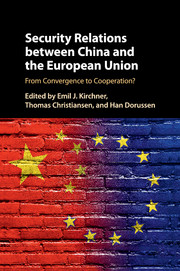Book contents
- Frontmatter
- Dedication
- Contents
- List of Tables
- Preface and Acknowledgements
- Abbreviations
- List of Contributors
- 1 EU–China Security Cooperation in Context
- 2 Chinese and EU Views of Military Security: Crafting Cooperation
- 3 Regional Solutions for Regional Confl icts? The EU, China and their Respective Neighborhoods
- 4 Aims versus Deeds: EU–China Cooperation in Nuclear Nonproliferation
- 5 Terrorism and Organized Crime: Common Concerns but Different Interests
- 6 Chinese and EU Climate and Energy Security Policy
- 7 Competing or Converging Claims on International Order? The EU, China and Human Security
- 8 Civil Protection: Identifying Opportunities for Collaboration
- 9 Cybersecurity and EU–China Relations
- 10 The Economic Security Dimension of the EU–China Relationship: Puzzles and Prospects
- 11 Is Securitizing Migration a Mandatory Choice? Lessons from the EU and China
- 12 Against the Odds: (Considerable) Convergence and (Limited) Cooperation in EU–China Security Relations
- Index
- References
3 - Regional Solutions for Regional Confl icts? The EU, China and their Respective Neighborhoods
Published online by Cambridge University Press: 05 September 2016
- Frontmatter
- Dedication
- Contents
- List of Tables
- Preface and Acknowledgements
- Abbreviations
- List of Contributors
- 1 EU–China Security Cooperation in Context
- 2 Chinese and EU Views of Military Security: Crafting Cooperation
- 3 Regional Solutions for Regional Confl icts? The EU, China and their Respective Neighborhoods
- 4 Aims versus Deeds: EU–China Cooperation in Nuclear Nonproliferation
- 5 Terrorism and Organized Crime: Common Concerns but Different Interests
- 6 Chinese and EU Climate and Energy Security Policy
- 7 Competing or Converging Claims on International Order? The EU, China and Human Security
- 8 Civil Protection: Identifying Opportunities for Collaboration
- 9 Cybersecurity and EU–China Relations
- 10 The Economic Security Dimension of the EU–China Relationship: Puzzles and Prospects
- 11 Is Securitizing Migration a Mandatory Choice? Lessons from the EU and China
- 12 Against the Odds: (Considerable) Convergence and (Limited) Cooperation in EU–China Security Relations
- Index
- References
Summary
Regional Threat Perceptions and Security Issues
The post-Cold War security landscape is increasingly characterized by regional security interactions (Buzan and Wæver 2003). Sub-system violent conflicts, often labeled “new wars” (Kaldor 1999) have become a core concern. While their novelty remains contested (e.g. Melander et al. 2009), such wars have become an integral part of security strategies. Thus, the 2003 European Security Strategy identified “regional conflicts” as a key threat (CEU 2003: 4). Asia, too, faces new security threats, including the effects of regional conflicts (Caballero-Anthony and Cook 2013). Both the EU and China show increasing concerns, for instance, about the instability and terrorist threats emanating from the Central Asian region (Lain 2014; CEU 2015: 6, 11).
To the EU, such regional conflicts are particularly relevant if they persist in the EU's own neighborhood. The wars in the context of the break-up of former Yugoslavia signified the failure and sparked the development of EU security policy (Juncos 2005; Kirchner 2006). In this context, the build-up of military capacities in the form of battlegroups and the construction of the European External Action Service (EEAS) as a diplomatic force on the EU level have received a lot of attention. Yet, at the same time, the EU is committed to the transformation of regional conflicts through civilian and political means and, in particular, through the promotion of regional integration. Meanwhile, the Asian context illustrates that regionalism is not equal to EU-style “institutional” integration. It may also take the form of “intergovernmental” regionalism, focused on states and “networked” regionalism, in which states and regional actors are connected in relatively decentralized yet interlocking webs and variable geometries (Yeo 2010).
Such comparisons of the EU's and China's regionalization policies are complicated by the fact that one is a regional organization and the other a “great power.” As a mature security community, the EU is committed to the transformation of its external security environment, using both power and values-based means to achieve normative ends. As an “authoritarian capitalist” “great power” (Gat 2007), China seeks to influence and shape its external security environment in ways that best benefit its nationalist ends. To China, regional conflicts are relevant if they have the potential to destabilize the regional security environment and adversely affect the region's (and hence China's) economic dynamism.
- Type
- Chapter
- Information
- Security Relations between China and the European UnionFrom Convergence to Cooperation?, pp. 42 - 62Publisher: Cambridge University PressPrint publication year: 2016
References
- 2
- Cited by



